RetroLisa
----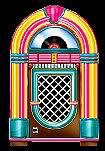 | __ | 1950s Town & Country | | |
|
___________________________________________________________________________________________________________
|
|
|
RetroLisa
_________________________________________________
|
|
|
RetroLisa
| ___________________________________________________________________ | __ | _____________________________ | _______ | Suburbs

new communities
In the late 1940s, a postwar housing shortage forced developers to search the open countryside for vacant land. Farm fields gradually gave way to paved streets, cul-de-sacs, landscaping and sidewalks.
Cookie-cutter ranch homes and split-level homes were designed with growing families in mind. Mass-produced tract homes were built quickly and cheaply, using prefabricated materials and factory techniques to create homes that had a tendency to all look alike.
Each type of suburb is named after the method of transportation that connects it to the city. In the old days, we had railroad, streetcar and early automobile suburbs. The postwar years gave us the freeway suburb. These communities were located several miles from the city center and were connected by the new freeways and expressways.
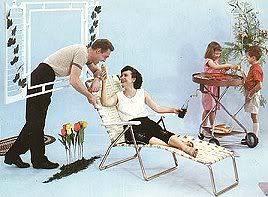
the good life
Although society had returned to a peacetime existence, the war had drastically altered our ideals, goals and lifestyles. We were living in a brand new world full of new attitudes....a world that was perfect for the suburban way of life.
- Veterans were marrying and settling down in record numbers. The resulting baby boom created a need for communities where children could grow up safe, healthy and happy.
- The general population was attaining a higher level of education, thanks in part to the G.I. Bill, which made it possible for war veterans to go to college.
- The G.I. Bill also insured mortgage lenders against loss, which made it easier for veterans to buy homes.
- Wartime technology created new industries and new jobs in the private sector, which in turn created new economic oppportunities for everyone.
- The prospering economy allowed people to buy more luxury goods.
As a result, young families with an eye to the future began to move out of the crowded cities. Americans had a renewed sense of optimism, and moving to the suburbs represented a fresh start.
Unfortunately, racial prejudices were still very much in evidence in the 1950s. Many of these subdivisions had covenants preventing blacks and Jews from buying homes there.
Levittown: An Ideal American Suburb
Early Years Of Marlton Hills
Levittown's Legacy Of Bias
The Automobile Shapes The Suburbs
Pennsylvania's Levittown
| |
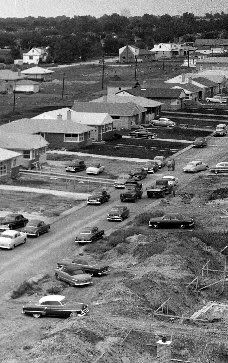
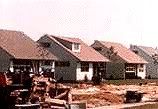
On Long Island, Levittown was the first major suburb of the postwar era.

There were no trees, and all the tract houses looked the same, but no one seemed to mind. The suburbs symbolized everything good that the modern world had to offer.
|
_________________________________________________
|
|
|
RetroLisa
| ___________________________________________________________________ | __ | _____________________________ | _______ | The City
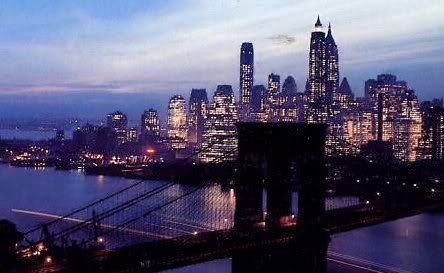
American cities were in a state of transition in the 1950s.
Our society was becoming increasingly urban. This trend began in the late 1800s with the advent of industrial technology, and showed no signs of slowing in the 1950s. During this decade, the number of Americans who lived in urban areas increased from 64 percent to 70 percent.
After the war, most of this urban growth took place in the suburbs. This had a negative impact on our cities. While the number of people who lived in urban areas increased, the percentage who actually lived in the city decreased. City dwellers fled their tiny flats and crowded streets for the green lawns and blue skies of the suburbs. Factories and retailers followed suit. As a result, once-vibrant neighborhoods began to show the first signs of urban decay.
It was at this time that the ideas of urban planning and urban renewal first took hold. Several government programs were put in place to clear out slum areas, remove open-air markets and replace crumbling buildings with new structures. Many older neighborhoods were demolished to make way for the freeways and expressways that were built in the late 1950s. The landscape of the city was changing.
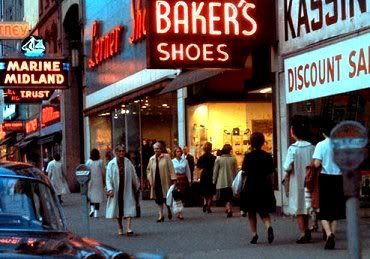
The city was bustling with crowded sidewalks, huge department stores and smaller shops.
Transportation was provided by streetcars and buses. In the 1950s, many cities were eliminating their streetcar lines and establishing bus routes.
For lunch, there were small cafes, soda shops and store lunch counters.
At night, the city came alive with neon lights, theaters and nightclubs.
Downtown Greensboro Memories
| |
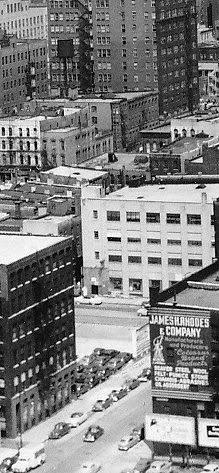
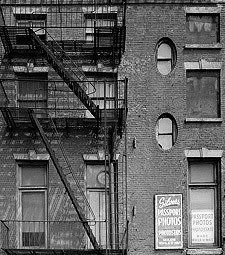
Tall buildings had brick fronts and fire escapes.
|
_________________________________________________
|
|
|
RetroLisa
| ___________________________________________________________________ | __ | _____________________________ | _______ | Shopping
This section hasn't been moved yet.
Please click the link below to
visit the original page:
1950s Shopping
| | |
_________________________________________________
|
|
|
RetroLisa
| ___________________________________________________________________ | __ | _____________________________ | _______ | Dining Out
This section hasn't been moved yet.
Please click the link below to
visit the original page:
1950s Dining Out
| | |
_________________________________________________
|
|
|
RetroLisa
| ___________________________________________________________________ | __ | _____________________________ | _______ | Nightlife
This section hasn't been moved yet.
Please click the link below to
visit the original page:
1950s Nightlife
| | |
_________________________________________________
|
|
|
RetroLisa
| ___________________________________________________________________ | __ | _____________________________ | _______ | Buildings & Businesses
 ------ ------
drive-in theaters
The first drive-in movie theater opened in the 1930s. Our passion for anything car-related in the 1950s made drive-ins immensely popular during this decade. Theaters charged admission per person, rather than per carload....that's when you found out just how many people you could squeeze into your trunk!

"There's a better show in the cars than on the screen."
Quite often, the ritual of going to the drive-in was more entertaining than the "B" movies being shown on the screen!
Drive-In Theater
Drive-In Resource Page
 ------ ------
personal services
For most women, a regular trip to the beauty parlor was a must! In addition to getting your hair done, beauty parlors and barbershops were great places to gather for the latest news or gossip.
In the 1950s, shoe-shine stands were still common sights on street corners and in train stations.
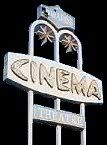
googie
Googie was a popular decorating style in the 1950s and 1960s. It was named after Googie's, a California coffeeshop famous for its modern, space-age look.

In the 1950s, space travel and atomic power were very hot topics. Any establishment that wanted to promote a modern or futuristic image used these concepts in their design.
The Googie movement first took hold in California, where coffeeshops and other public buildings were designed with large expanses of glass, synthetic materials, exposed metal beams and upswept roofs. Signs weren't complete until they had a starburst, atom or sputnik at the very top. Inside, pastel colors were prevalent and aerodynamic shapes enhanced the illusion of space travel and flight. Disneyland's Tomorrowland was Googie in the extreme.
Googie Architecture Online
The Mid-Century Art Of Nat Reed
Roadside Peek
| |

A typical drive-in had a playground for the kids. Some locations had extra attractions, like carousels and pony rides. Between movies, the screen showed advertisements for the goodies you could get at the concession stand.
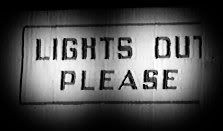
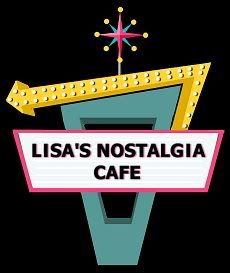
|
_________________________________________________
|
|
|
RetroLisa
| _____________________________________________________________ | __ | ___________________________________ | _______ | The Country
After the war, modern technology transformed rural life in America.
By the 1950s, farming had become a science. Modern machinery, improved breeding methods and hybrid crops helped farmers produce more with less labor.
Electricity and improved transportation also contributed to the modernization of the family farm. Hard-surfaced roads made it easy to take produce to market and livestock to auction. Electricity made milking machines, water pumps, incubators and heaters for the barn possible. Modern dairy farms had bulk cooling tanks on the premises, and raw milk was transported directly from the farm to the processing plant in bulk tank trucks. Hauling heavy milk cans was a thing of the past.
The intense isolation of farm life was also a thing of the past. The radio and TV provided news and entertainment, and the Rural Free Delivery service brought mail right to the farm. Buses took the kids to modern consolidated schools in town, and the city was only an hour away by car.
After school, many farm kids participated in their local 4-H Club. The 4-H organization was formed in the 1910s, and had its origins in the various corn clubs and canning clubs of the 1900s. Whether it was raising calves, sewing or cooking, the 4-H Club was a great place for young people to learn by doing.
Although most farms were wired for electricity in the 1930s and 1940s, you could still find an occasional farm home that didn't have electricity or indoor plumbing. Taking a trip to the old "two-holer" out back was still a reality for these farm families.
Rural phone service was a bit behind the times. While the rest of the country was being hooked up to the new long-distance direct dialing system, farmers still relied on the operator for their long-distance calls. Many farmers were also still hooked up to party lines.
4-H Clubs
| |
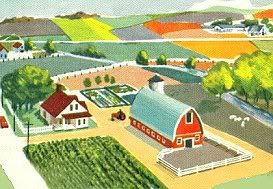
|
_________________________________________________
|
|
|

